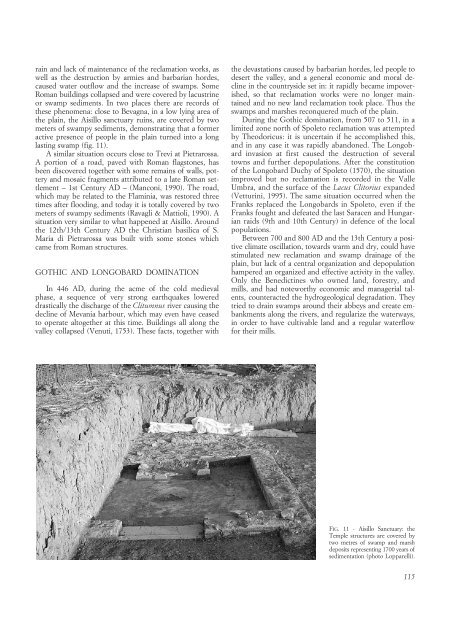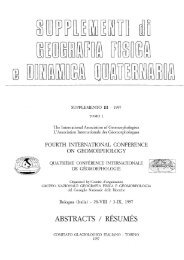Full Text (PDF)
Full Text (PDF)
Full Text (PDF)
Create successful ePaper yourself
Turn your PDF publications into a flip-book with our unique Google optimized e-Paper software.
ain and lack of maintenance of the reclamation works, as<br />
well as the destruction by armies and barbarian hordes,<br />
caused water outflow and the increase of swamps. Some<br />
Roman buildings collapsed and were covered by lacustrine<br />
or swamp sediments. In two places there are records of<br />
these phenomena: close to Bevagna, in a low lying area of<br />
the plain, the Aisillo sanctuary ruins, are covered by two<br />
meters of swampy sediments, demonstrating that a former<br />
active presence of people in the plain turned into a long<br />
lasting swamp (fig. 11).<br />
A similar situation occurs close to Trevi at Pietrarossa.<br />
A portion of a road, paved with Roman flagstones, has<br />
been discovered together with some remains of walls, pottery<br />
and mosaic fragments attributed to a late Roman settlement<br />
– 1st Century AD – (Manconi, 1990). The road,<br />
which may be related to the Flaminia, was restored three<br />
times after flooding, and today it is totally covered by two<br />
meters of swampy sediments (Ravagli & Mattioli, 1990). A<br />
situation very similar to what happened at Aisillo. Around<br />
the 12th/13th Century AD the Christian basilica of S.<br />
Maria di Pietrarossa was built with some stones which<br />
came from Roman structures.<br />
GOTHIC AND LONGOBARD DOMINATION<br />
In 446 AD, during the acme of the cold medieval<br />
phase, a sequence of very strong earthquakes lowered<br />
drastically the discharge of the Clitumnus river causing the<br />
decline of Mevania harbour, which may even have ceased<br />
to operate altogether at this time. Buildings all along the<br />
valley collapsed (Venuti, 1753). These facts, together with<br />
the devastations caused by barbarian hordes, led people to<br />
desert the valley, and a general economic and moral decline<br />
in the countryside set in: it rapidly became impoverished,<br />
so that reclamation works were no longer maintained<br />
and no new land reclamation took place. Thus the<br />
swamps and marshes reconquered much of the plain.<br />
During the Gothic domination, from 507 to 511, in a<br />
limited zone north of Spoleto reclamation was attempted<br />
by Theodoricus: it is uncertain if he accomplished this,<br />
and in any case it was rapidly abandoned. The Longobard<br />
invasion at first caused the destruction of several<br />
towns and further depopulations. After the constitution<br />
of the Longobard Duchy of Spoleto (1570), the situation<br />
improved but no reclamation is recorded in the Valle<br />
Umbra, and the surface of the Lacus Clitorius expanded<br />
(Vetturini, 1995). The same situation occurred when the<br />
Franks replaced the Longobards in Spoleto, even if the<br />
Franks fought and defeated the last Saracen and Hungarian<br />
raids (9th and 10th Century) in defence of the local<br />
populations.<br />
Between 700 and 800 AD and the 13th Century a positive<br />
climate oscillation, towards warm and dry, could have<br />
stimulated new reclamation and swamp drainage of the<br />
plain, but lack of a central organization and depopulation<br />
hampered an organized and effective activity in the valley.<br />
Only the Benedictines who owned land, forestry, and<br />
mills, and had noteworthy economic and managerial talents,<br />
counteracted the hydrogeological degradation. They<br />
tried to drain swamps around their abbeys and create embankments<br />
along the rivers, and regularize the waterways,<br />
in order to have cultivable land and a regular waterflow<br />
for their mills.<br />
FIG. 11 - Aisillo Sanctuary: the<br />
Temple structures are covered by<br />
two metres of swamp and marsh<br />
deposits representing 1700 years of<br />
sedimentation (photo Lopparelli).<br />
115















